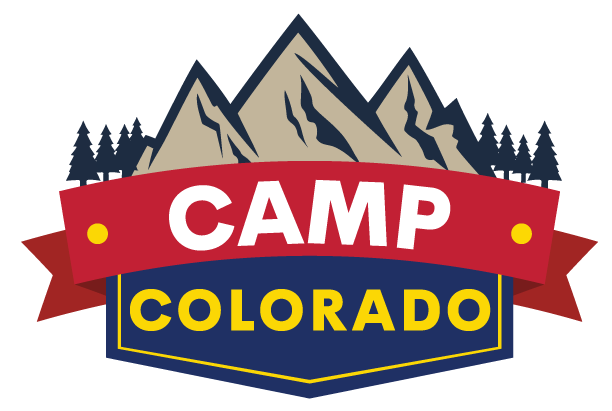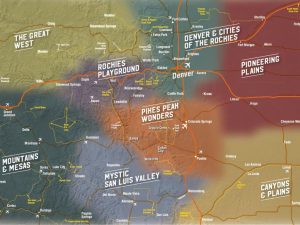“Where should I camp in Colorado?” Aside from not knowing your preference of camping accommodations (tent, RV, cabin, yurt, lodge, tepee, covered wagon, safari tent, or any other means of enjoying the outdoors), there are many other factors to consider. For example:
- Colorado is the country’s eighth largest state. It covers 104,094 square miles, running 280 miles north-south and 380 miles east-west.
- The landscape is varied from the eastern High Plains to the rock sides of Rocky Mountains to the tundra of the highest of the stretches.
- The climate swings from the arid desert to areas where it’s always cool.
- Downtown Denver is one mile above sea level, the lowest elevation in the state is 3,317’ and the highest is 14,440’ at the top of Mount Elbert.
So, the answer is something each person needs to determine, and Camp Colorado is here to assist. While Colorado residents most often refer to the High Plains, the Front Range, the I-25 Corridor, and the Western Slope, the state recently unveiled a new map of eight regions. We’ll outline each one so you’ll then be more familiar as you use the map and search criteria on our Find a Campground page.
This shows the eight regions we’re discussing:
These plains of Northeast Colorado offer grasslands where there isn’t much to buffer you from the wind. Winter is very chilly and summer is hot and dry. Colorado’s earliest settlers established farms here, some of which are still in operation by descendants of those hearty early travelers.
This link provides more information on the Pawnee National Grassland.
Travelers, be careful to not unintentionally start a grassfire either by carelessness or by having your vehicle’s underside spark the grass afire.
Southeast Colorado continues the grassy plains, and the climate is cold in the winter and hot and dry in the summer. Bird watchers usually find many pleasing sightings to photograph.
This area is home to the Mexican America trade route of the Santa Fe Trail. While the main roads in the territory are paved today, once you leave the main road you’ll probably find yourself on a dirt road.
Authentic Hispanic and Native American cultures are found in this region although most of the area isn’t established in tourism events. Take time to research the area to gain an appreciation of what’s out there.
Here are some links for history buffs:
Again, travelers, be careful to not unintentionally start a grassfire.
This is in central Colorado and includes Colorado Springs, runs up the slope to Pikes Peak and down the other sides to Buena Vista and Cañon City. The Arkansas River forms the Royal Gorge and offers fantastic fishing in a truly scenic setting. Roadways lead you to places you might not expect, such as to the top of Pikes Peak. Outdoor adventures from hiking to fishing and kayaking, cultural centers, historic tours, natural formations, cuisine, local spirits, craft beverages … you will find it all in this region! Don’t overlook these two:
The central part of southern Colorado welcomes you to vast differences within its own region, from the Great Sand Dunes National Park to peaks of more than 14,000 feet high. The outdoors calls people to this region, as does the Native American and Hispanic heritage.
We suggestion starting here:
This region runs from Four Corners of southwest Colorado to I-70, and includes so much Adventureland that it’s not so easy to be concise.
Those who aren’t familiar with Colorado are often surprised to see red rock wonders wandering this way and that, some seemingly appearing as stunning, gigantic stalagmites arising from the earth. When you realize how close you are to Utah and Arizona, well, it all makes sense.
A bit of research unveils 11,000 years of history with the Ute Mountain Tribe and the Ancient Puebloans. The mining towns of the San Juan Mountains provide more recent history. Driving the Million Dollar Highway from Durango to Silverton and back down again to Ouray is a trek for the brave, and their reward is truly amazing memories. Another stellar trek is from Dolores to Telluride. The sights and scenery are unlike anywhere else!
Another portion of this region one shouldn’t overlook is a trek from Montrose to Gunnison, right by Blue Mesa Reservoir. Fishing is fantastic, the Bighorn Sheep might make an appearance, and the scenery will truly amaze you!
Heading north, coming out red rock canyons, the lush orchards around Grand Junction and Palisade come into view. The backdrop is Grand Mesa, the largest flat-topped mountain in the world! It stretches for 40 miles east of Grand Junction, between the Colorado River and the Gunnison River.
In this part of the region you’ll find savory wines, microbreweries, delicious peaches, incredible farm produce. You’ll consider moving here!
Outdoor enthusiasts enjoy mountain biking, off-road vehicles, rafting, boating, fishing, canyoneering, cycling, hiking, and kayaking (to name a few). Winter camping is available in the region, so let’s not overlook skiing and ice climbing.
Central Colorado is home to the Rockies Playground, and it’s this area that campers from around the globe flock to experience. They also come from all around Colorado because the Rockies are the playground of all Colorado residents.
Whether you’re escaping from summer’s sizzling heat or you want to feel the air at 14,000 feet, you’re going to find many others with the same intentions. (That means you should book early!)
We invite you to enjoy this region’s hiking, mining towns, mountain towns, majestic peaks, rafting, mountain biking, nightlife, arts, festivals, museums, microbreweries, golfing, star-gazing, cuisine, and, well, the list is rather endless!
Due to the early onset of winter, and its late departure, most campgrounds in this region have a shorter season. Those who book early have the best chance of getting a campsite before availability is gone, especially near summer holidays. (Fortunately for some, most parks will put you on a waiting list and will let you know if anyone cancels.)
Some advice: pack a blanket, a jacket, and long pants. Better safe than sorry!
Here’s another region that’s filled with diversity from the high tundra and rolling hills to landscape you often see in Wild West films. You’ll see vast livestock ranches and maybe even some cattle drives. Independent ranchers prefer this expanse since are no genuine population centers to speak of.
But wait! This region also includes Walden, which is home to Lake John. Fishing! Oh my, great fishing all year. Get your boat or your ice drilling gear ready.
If you haven’t traveled from Rand to Walden brace yourself for beauty! Aside from seeing moose, it’s breathtaking to look at the incredibly towering peaks way off in the distance to the east and to the west from down in this ‘plain’ that is over 8,600’ above sea level. Just remembering the drive brings peace to the soul.
Outdoor adventures include hunting, fishing, horseback riding, kayaking, canoeing, star-gazing and off-road adventures. Of course, there’s also skiing at Steamboat Springs.
DENVER & CITIES OF THE ROCKIES REGION
There’s something magically picturesque about the Denver skyline with the Rockies Mountains in the background. Many campers want to experience the Capitol in downtown Denver, and the US Mint, as well as taking in some sporting events.
Those who camp in this region often choose to do so more remotely and commute for the actual downtown activities. The local residents who commute to offices in downtown often do so from as far as Fort Collins or Greeley to the north and Larkspur or Monument to the south, all along the I-25 corridor. There’s an advantage to camping in Black Hawk, to the northwest, in that you’ll be surrounded by nature yet have a fairly easy commute.
Obviously, in this region you have access to a wide range of festivals and fairs, art events, museums, cuisine, microbreweries, entertainment venues, and everything that a metropolitan city offers. The most striking difference between this metro city and all others is that it’s the gateway to Rocky Mountains!
THE HARDEST PART
There’s no simple answer for where you should camp! We know we’re biased but we’ll say it anyway. We hope you will stay awhile to take in more, and that you’ll return over and over again!
Our Find a Campground page makes it easier to narrow the list of campground to those which suit your preferences.
Please reference our blog post on adjusting to the elevation. Even those who travel to eastern high plains can experience altitude sickness. Our blog addresses some very simple ways to avoid this very common condition.
The Colorado Tourism Office provides additional travel ideas in the regions in this post.
This publication is supported by funding from the Colorado Tourism Office, a state agency. Turn to Colorado.com for a comprehensive list of festivals, events, historic areas, itineraries, and community insight.






